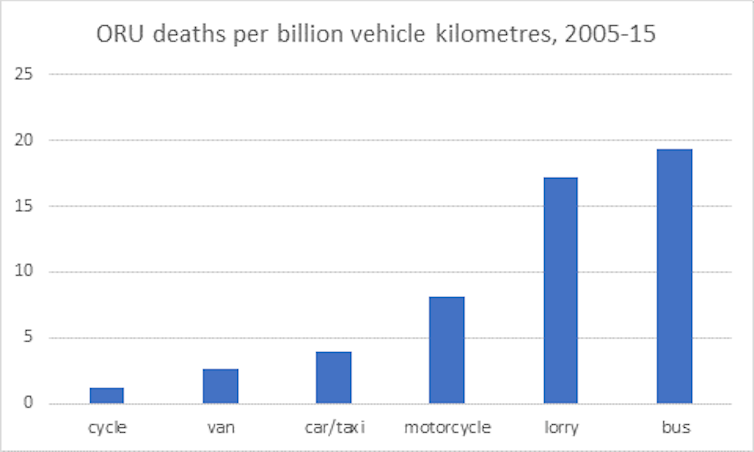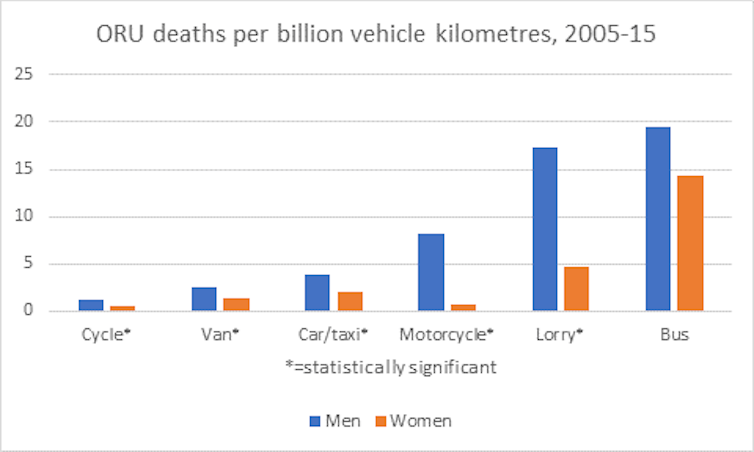Rachel Aldred and James Woodcock write about new research examining the risk posed to other road users by particular types of transport. This post was originally published in The Conversation.
Analysis from the UK Department for Transport compares the risk of being injured when you are cycling, driving or walking. Motorcyclists have an especially high risk of death, followed by pedestrians and cyclists. Those in vans, buses or lorries are safest.
But this is only half the story. Our research found that while motorcyclists themselves have a high risk of being killed, motorbikes also pose a startlingly high risk to others. Per kilometre, motorcycling kills twice as many other people as car driving.
In addition, the majority – more than eight out of ten – of cyclist fatalities occurred when the cyclist was hit by a motor vehicle. In most cases, it’s not cycling itself that kills: it’s colliding with heavy, powered vehicles.
Our new research shows how many deaths to other people different types of vehicles cause. We’ve also examined how the gender of the person driving or riding affects the amount of other-party deaths.
The missing picture
Our analysis calculates fatalities to other road users per billion vehicle kilometres in England. This works out how many deaths to other people result from a given amount of travel by a particular type of vehicle. It does not include deaths to passengers in crashes involving only one vehicle.

Author provided
Cycling is relatively safe for others, while car driving kills three times as many other people per kilometre as cycling. If we used bikes for short trips rather than cars, lives could be saved.
Just under a fifth (18%) of kilometres travelled by car come from trips under five miles. Imagine that we were able to shift around half those trips to cycling. If we shifted 9% of the distance currently travelled by car on non-motorway roads, this adds up to 14 billion km annually. Our data shows 619 other-party deaths each year linked to cars. So a 9% fall in car kilometres might mean 56 fewer other-party deaths, annually.
Rocksweeper/Shutterstock
The average car occupancy is 1.6 people, so this implies 22 billion km more cycled annually. This is a fivefold increase from currently low levels. The Dutch, with a population a third that of England’s, managed to rack up 15.5 billion bicycle kilometres in 2016.
Based on the rates calculated above, we would expect 22 billion kilometres cycled to lead to an extra 27 other-party fatalities annually. In total, this shift from cars to cycling would mean 29 fewer other-party deaths each year.
There are many reasons to support a shift from driving to cycling. A substantial rise in cycling would have major physical activity benefits. The impacts of cycling tool, which calculates health benefits from physical activity, suggests a five-fold increase in cycling might prevent over a thousand premature deaths annually in England.
Gender gap
Our analysis also looked at differences between men and women. Despite the long-held popular belief that women are bad drivers, research finds that men have more negative attitudes towards road safety. For instance, they are more tolerant of speeding than women. So the increased gender equality in car driving may have helped reduce traffic injuries, though this is under-researched.
However, men remain disproportionately in charge of the most dangerous vehicles. At least 90% of van or bus drivers are male, as are over 95% of lorry drivers. While an individual lorry driver or passenger might be safe in their big metal box, those outside the vehicle aren’t. Each lorry kilometre leaves over six times more fatalities than each van kilometre.
Our research calculated the impact gender has on other-party deaths. For five of the six transport modes, men posed much higher risk than women. For buses, the risk per km associated with male drivers was higher, but the difference wasn’t statistically significant. Due to data limitations we can’t be as confident about the results for commercial and public service transportation. However, car, motorcycle, and cycle risks – where data is better – show a substantial gender gap, suggesting it is real even if there is uncertainty about its size for larger vehicles.

Author provided
We calculated what might happen to other party deaths if men and women shared the distance driven by van and by lorry equally. Over the 11-year period of our analysis, gender parity for van driving would imply 343 fewer other-party deaths, and 866 fewer deaths for lorry driving. This suggests that there would be around 100 fewer other-party deaths per year if van and lorry driving was 50-50 male-female, rather than over 90% male.![]()
Rachel Aldred, Reader In Transport, University of Westminster and James Woodcock, Principal Research Associate, MRC Epidemiology Unit.
- This article is republished from The Conversation under a Creative Commons license. Read the original article.
- Read a related news piece: Men pose more risk to other road users than women

 MRC Epidemiology Unit
MRC Epidemiology Unit